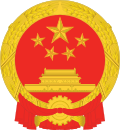President of China
Appearance
(Redirected from President of the People's Republic of China)
| President of the People's Republic of China
中华人民共和国主席 | |
|---|---|
 | |
 | |
| Style | Mr. President (主席) (formal) His Excellency (阁下) (diplomatic) |
| Status | Head of state Commander-in-chief |
| Residence | Zhongnanhai |
| Seat | West Building, Zhongnanhai, Beijing (de jure) |
| Nominator | Presidium of the National People's Congress |
| Appointer | National People's Congress |
| Term length | Five years Renewable; No term limits |
| Constituting instrument | Constitution of the People's Republic of China |
| Inaugural holder | Mao Zedong |
| Formation | 27 September 1954 18 June 1983 |
| Abolished | January 1975 – December 1982 |
| Deputy | Vice President |
| Salary | ¥152,121 RMB ($22,000 USD)[1] |
| Website | Presidency |
| President of the People's Republic of China | |||||||||||
| Simplified Chinese | 中华人民共和国主席 | ||||||||||
|---|---|---|---|---|---|---|---|---|---|---|---|
| Traditional Chinese | 中華人民共和國主席 | ||||||||||
| Literal meaning | Chinese People Republic Chairperson | ||||||||||
| |||||||||||
| Alternative Chinese name | |||||||||||
| Simplified Chinese | 国家主席 | ||||||||||
| Traditional Chinese | 國家主席 | ||||||||||
| Literal meaning | State Chairperson | ||||||||||
| |||||||||||
| Politics of China |
|---|
 |
The President of China (officially President of the People's Republic of China) is the head of state of the People's Republic of China (PRC). On paper, the presidency is a largely ceremonial office with limited powers. However, in recent years the General Secretary of the Communist Party has also served simultaneously as President. His election to the office makes him paramount leader of China.[a] The office is classified as an institution of the state rather than an administrative post.[2]
The current President is Xi Jinping. He took office on 14 March 2013.
References
[change | change source]- ↑ The office of the President is a prestigious one. The President is the Head of the State. The Constitution of 1982 restores powers and functions of the President for the first time after the office was abolished during the Cultural Revolution. The President is a largely ceremonial position.
- ↑ "Public employees get salary increase - China - Chinadaily.com.cn". www.chinadaily.com.cn. Archived from the original on 5 June 2019. Retrieved 4 November 2019.
- ↑ It is listed as such in the current Constitution; it is thus equivalent to organs such as the State Council, rather than to offices such as that of the Premier.

